1911 Trigger Changes
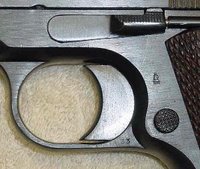 One of the beautiful things about Browning's brainchild is the single action trigger can be tuned to extremely light pull weights and extremely short strokes. In bullseye shooting, it is not uncommon for pistols to have triggers so light that hummingbirds hovering nearby can set them off (not really, but almost). Trigger pulls this light are desirable in bullseye to achieve extremely precise marksmanship.
One of the beautiful things about Browning's brainchild is the single action trigger can be tuned to extremely light pull weights and extremely short strokes. In bullseye shooting, it is not uncommon for pistols to have triggers so light that hummingbirds hovering nearby can set them off (not really, but almost). Trigger pulls this light are desirable in bullseye to achieve extremely precise marksmanship.A problem arose with the 1911 however. Under recoil, the heavy machined steel trigger would bounce, causing the pistol to shoot doubles, and sometimes triples at very light trigger weights. The wider trigger shoes often affixed to 1911 triggers in those days only exacerbated the problem. The first solution was to drill holes in the steel trigger shoe to lighten it up. A lighter trigger would not be so subject to bouncing under recoil. In those days, aftermarket parts were not available, and gunsmiths fabricated parts rather than swapping them out.
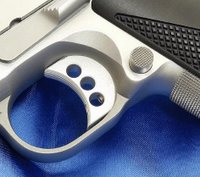 Soon, three round holes in your trigger became the sign of a top flight trigger job. Then aluminum triggers came on the market. Of course, the new fangled lightweight aluminum triggers had the same three holes, so everyone would know you had a trigger job on your pistol. These triggers have a set screw in them for overtravel adjustment, but they have no provision for pre-travel. If I remember correctly, Videcki was the first out the chute with this lightweight "pow button", and Bill Wilson was quick to catch up. This type of trigger is today frequently seen in off the shelf pistols.
Soon, three round holes in your trigger became the sign of a top flight trigger job. Then aluminum triggers came on the market. Of course, the new fangled lightweight aluminum triggers had the same three holes, so everyone would know you had a trigger job on your pistol. These triggers have a set screw in them for overtravel adjustment, but they have no provision for pre-travel. If I remember correctly, Videcki was the first out the chute with this lightweight "pow button", and Bill Wilson was quick to catch up. This type of trigger is today frequently seen in off the shelf pistols.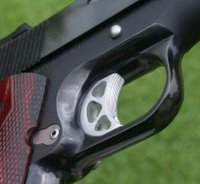 Other, even lighter triggers soon appeared on the market. One of my old favorites, the Dlask trigger, has a magnesium shoe and titanium stirrup. It can be adjusted for pre-travel as well as over-travel. The Dlask trigger was my favorite for a long time, simply because of that adjustment capability. Then, Chip McCormick introduced his lightweight trigger which caused a sensation. It was a less expensive trigger than the Dlask, but allows the same adjustments. There are other triggers available with changeable shoe lengths, plastic shoes, and even shoes with ball bearings. None of these special triggers constitutes a trigger job by itself. A 1911 trigger job occurs on the sear and hammer hooks, not in the trigger guard. Like chrome valve covers on a hot rod engine, these aftermarket triggers are just visible indicators that a trigger job has been performed on the gun.
Other, even lighter triggers soon appeared on the market. One of my old favorites, the Dlask trigger, has a magnesium shoe and titanium stirrup. It can be adjusted for pre-travel as well as over-travel. The Dlask trigger was my favorite for a long time, simply because of that adjustment capability. Then, Chip McCormick introduced his lightweight trigger which caused a sensation. It was a less expensive trigger than the Dlask, but allows the same adjustments. There are other triggers available with changeable shoe lengths, plastic shoes, and even shoes with ball bearings. None of these special triggers constitutes a trigger job by itself. A 1911 trigger job occurs on the sear and hammer hooks, not in the trigger guard. Like chrome valve covers on a hot rod engine, these aftermarket triggers are just visible indicators that a trigger job has been performed on the gun.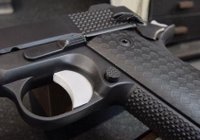 Today, most off the shelf 1911s have skeletonized aluminum triggers. These are usually of the three hole "Videcki" design, making the triangular holed McCormick trigger the sign of the custom trigger job. Ironically, many top flight pistolsmiths are moving back to the solid aluminum trigger today. The skeletonized aluminum triggers were and are all about fashion. The skeletonization is simply not needed in an aluminum trigger. Thus, the 1911 trigger has come almost full circle in outward appearance. What is old is new again.
Today, most off the shelf 1911s have skeletonized aluminum triggers. These are usually of the three hole "Videcki" design, making the triangular holed McCormick trigger the sign of the custom trigger job. Ironically, many top flight pistolsmiths are moving back to the solid aluminum trigger today. The skeletonized aluminum triggers were and are all about fashion. The skeletonization is simply not needed in an aluminum trigger. Thus, the 1911 trigger has come almost full circle in outward appearance. What is old is new again.Labels: 1911 Basics


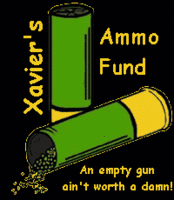





10 Comments:
Lovely explanation. As Pop says, "I'm learning so much that I'm gonna get a headache".
One thing; I think I understand pre-travel (take-up the slack, right?) but what's over-travel and why is he a problem?
You are correct. Pre-travel is often called take-up.
Overtravel is the distance the trigger continues to move after the sear breaks.You need a little, but youwant to keep it at a minimum for a rapid trigger reset and follow-up shot.
Another well written piece that flows perfectly. Pictures really make your point of whats old is new again. -bp78
Excellent article. Wish I could write as clearly as you do! I'll go put up a post pointing to the post.
.....Mr. C.
Very interesting, especially seeing as i just installed a Chip McCormick trigger on the Colt.
Ya know, the funny thing is I couldn't stand the black plastic trigger on my Colt 1991A1 but now that I have the Chip McCormick triangled aluminum adjustable trigger, it really doesn't go with the gun either.
What I'd like to find is a nice steel/aluminum trigger in either brushed stainless or simply black.
Any recommendations?
Check with your friendly neighborhood gunsmith. I bet he has a few in the take off bin. If not, CDNN has solid triggers. The shipping is steep though.
this post explains clearly what many people fail to understand. thank you.
As Clint Smith points out, the little holes in the triggers are just one more place for dirt and gunk to reside to later foul up your weapon.
I learned the hard way that screws and holes in a trigger are just more ways to make things go wrong. I had built a custom 1911 for IDPA single stack that was a real tack driver, I liked it so much I started carrying it. After having the trigger screw go out of adjustment rendering the gun completely useless durring a self defense class (luckily I brought a G.I. spec 1911 as backup that allowed me to finish the class) I vowed to never use a screwy-swish cheese trigger for self defense/carry ever again. I also learned after watching a scary and embarrasing accidental discharge to never carry a 1911 with less than a 4-lb trigger.
I like the Chip McCormick trigger with the takeup and overtravel ajustments.I did locktight the screw and changed the color to a dark grey with Birchwood aluminum black. The trigger works very well and looks good too.
Post a Comment
<< Home